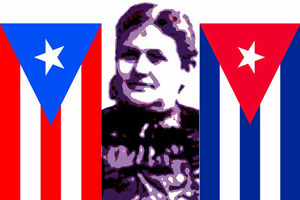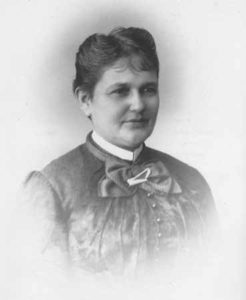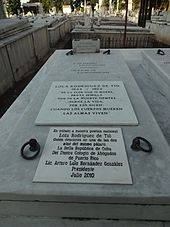Thousands of Cubans and non-Cubans replicate a tenth dedicated to Cuba, but they do not say the complete poetry, nor do they identify the poet who had delirium with Cuba, and even lived there for some time there sharing with the Cubans and is where she dies.
Lola Rodriguez de Tio, (September 14, 1843 – November 10, 1924), was the first Puerto Rican-born woman to establish herself as a great poet throughout Latin America. A believer in women’s rights, she was also committed to the abolition of slavery and the independence of Puerto Rico.
Rodríguez de Tió received her education at home where she was home-tutored. She has developed a lifelong love for literature, especially for the works of Fray Luis de Leon, who were the source of inspiration. She was very assertive in her early years, at the age of seventeen she demanded to wear her hair short, which went against the conventional norm of the time, to personal trademark that she kept through her life.
Rodriguez de Tió moved to Mayagüez, with her family. There she met Bonocio Tió Segarra, whom she married in 1863. Rodríguez de Tió became a writer and book importer who often wrote articles in the local press and was much of an activist against the Spanish regime as allowed by the government.
In 1867 and then again in 1889, Rodriguez de Tio and her husband were banished from Puerto Rico by the Spanish appointed Governors. On their first exile they went to Venezuela and on their second banishment they first moved to New York where she helped José Martí and other Cuban revolutionaries, and later to Cuba, where the couple resided until their respective deaths.
In 1901, Rodriguez de Tió founded and was a member of the Cuban Academy of Arts and Letters. She was also an inspector of the local school system. She was well known in Cuba for her patriotic poetry about Puerto Rico and Cuba. Some of Rodríguez de Tió’s best known works are “Cuba and Puerto Rico are …” (Cuba and Puerto Rico are ..) and “My Book of Cuba” (My Book about Cuba).
In 1919, Rodriguez de Tio returned to Puerto Rico where she was honored with a great banquet at the Puerto Rican Athenaeum after she recited her “Cantos a Puerto Rico”.
It is believed by some that the design and colors of the Puerto Rican Flag, which were adopted in 1954, came from Rodriguez de Tió’s idea of having the same flag as Cuba with the colors reversed.
Lola Rodriguez de Tió died on November 10, 1924 and is buried at the Colón Cemetery in Havana, Cuba.
CUBA Y PUERTO RICO: “DE UN PAJARO LAS DOS ALAS”, LOLA RODRÍGUEZ DE TIO.
Miles de cubanos y no cubanos replican una décima dedicada a Cuba, pero no dicen la poesía completa, además no identifican a la poetisa que tenía delirio con Cuba, e incluso vivió algún tiempo allí compartiendo con los cubanos y es donde muere.
Lola Rodríguez de Tió, (September 14, 1843 – November 10, 1924), was the first Puerto Rican-born woman poet to establish herself a reputation as a great poet throughout all of Latin America. A believer in women’s rights, she was also committed to the abolition of slavery and the independence of Puerto Rico.
Rodríguez de Tió received her education at home where she was home-tutored. She developed a lifelong love for literature, especially for the works of Fray Luis de León which were to serve her as a source of inspiration. She was very assertive in her early years, at the age of seventeen she demanded to be allowed to wear her hair short, which went against the conventional norm of the time, a personal trademark that she kept through her life.
Rodríguez de Tió moved to Mayagüez, with her family. There she met Bonocio Tió Segarra, whom she married in 1863. Rodríguez de Tió became a writer and book importer who often wrote articles in the local press and was as much of an activist against the Spanish regime as was allowed by the government.
In 1867 and then again in 1889, Rodríguez de Tió and her husband were banished from Puerto Rico by the Spanish appointed Governors. On their first exile they went to Venezuela and on their second banishment they first moved to New York where she helped José Martí and other Cuban revolutionaries, and later to Cuba, where the couple resided until their respective deaths.
In 1901, Rodríguez de Tió founded and was elected member to the Cuban Academy of Arts and Letters. She was also an inspector of the local school system. She was well known in Cuba for her patriotic poetry about Puerto Rico and Cuba. Some of Rodríguez de Tió’s best known works are “Cuba y Puerto Rico son…” (Cuba and Puerto Rico are..) and “Mi Libro de Cuba” (My Book about Cuba).
In 1919, Rodríguez de Tió returned to Puerto Rico where she was honored with a great banquet at the Ateneo Puertorriqueño after she recited her “Cantos a Puerto Rico”.
It is believed by some that the design and colors of the Puerto Rican Flag, which were adopted in 1954, came from Rodríguez de Tió’s idea of having the same flag as Cuba with the colors reversed.
Lola Rodríguez de Tió died on November 10, 1924 and is buried at the Colón Cemetery in Havana, Cuba.
Agencies/Wiki/Internet Photos/Extractos/Arnoldo Varona/TheCubanHistory.com
THE CUBAN HISTORY, HOLLYWOOD.







